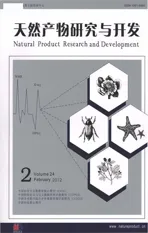观光木酚性成分研究
2012-02-14常睿洁金慧子张卫东
黄 鹰,常睿洁,金慧子*,张卫东,2*
1上海交通大学药学院,上海200240;2上海第二军医大学药学院,上海200433
Introduction
Tsoongiodendron odorum Chun(Magnoliaceae)is an evergreen tree,mainly distributed in south of China,such as Jiangxi,Guangdong,Yunnan and so on[1].The stem barks and root barks of this plant have been used to treat cancer by the local people for a long time.Up to now,only a few chemical constituents have been isolated from this plant[2-4].In this study on the twigs of T.odorum,eleven phenolic constituents were isolated and identified as p-hydroxybenzaldehyde(1),vanillin (2),1,3,5-trimethoxybenzene(3),4-hydroxy-3,5-dimethoxy-benzaldehyde(4),vanillic acid(5),threo-2, 3-bis-(4-hydroxy-3-methoxyphenyl)-3-methoxy-propanol (6),erythro-2,3-bis-(4-hydroxy-3-methoxyphenyl)-3-methoxy-propanol(7),syringic acid(8),3-hydroxy-1-(4-hydroxy-3,5-dimethoxyphenyl)-1-propanone(9),p-hydroxyl phenethanol(10),and C-veratroylglycol (11).Compounds 1-4 and 6-11 were isolated from this plant for the first time.
Experimental
General procedures
All melting points were determined on an RY-1 micromelting point apparatus(uncorrected).The ESIMS were measured on an Agilent 1100 series mass spectrometer.NMR spectra were measured on a Bruker DRX-500 spectrometer,operating at 500 MHz for1H and 125 MHz for13C NMR.Chemical shift(δ)were given in ppm relative to TMS as internal standard and coupling constants in Hz.Silica gel(200-300 mesh, Yantai,China)was used for column chromatography,and precoated silica GF254plates were used for TLC (Qingdao Haiyang Chemical Co.,Ltd.,China).Semipreparative HPLC was obtained on a Shimadzu LC-6AD series equipped with an SPD-20 spectrophotometer using a Zorbax-SB-C185 μm(9.4×250 nm,ID).
Plant material
The twigs of T.odorum were collected from Jiangxi Province of China in July,2008 and identified by Prof.Huang Bao-kang,Department of Pharmacognosy,School of Pharmacy,Second Military Medical University.A voucher specimen was deposited at School of Pharmacy,Shanghai Jiao Tong University.
Extraction and Isolation
The air-dried and powdered twigs of T.odorum(10.0 kg)were extracted with 80%EtOH for three times at room temperature.The solvents were concentrated under vacuum to yield a residue(525.0 g).The residue was dissolved in water(5.0 L)and extracted successively with petroleum ether(5.0 L×10),ethyl acetate (5.0 L×10)and n-butanol(5.0 L×10)to give corresponding fractions A(38.5 g),B(83.6 g),and C (185.5 g).Fraction B was subjected to silica gel column chromatography with a step gradient of CH2Cl2-MeOH(100∶1-0∶100)to give 12 fractions B1—B12.Fraction B2 was separated on silica gel column eluted by CH2Cl2-MeOH(20∶1-1∶1)to give 8 fractions B21—B28.Fraction B21 was subjected repeatedly to silica gel column chromatography and further purified successively through semi-HPLC to yield compounds 1 (7.0 mg),2(10.0 mg),3(60.0 mg),and 4(32.5 mg).Similarly,fraction B22—B24 were purified in the same manner to yield compounds 5(30.0 mg),6(1.5 mg),7(1.5 mg),8(4.5 mg),9(6.2 mg)(5-9 from B22),10(12.0 mg,from B23),and 11(7.5 mg,from B24).
Results and Discussion
p-Hydroxybenzaldehyde(1)C7H6O2,white needle crystal(CH3OH),mp.110~112℃;ESI-MS m/z:121[M–H]–;1H NMR(CD3OD)δ:9.76(1H,s,CHO-1),7.77(2H,d,J=8.5 Hz,H-2,6),6.91 (2H,d,J=8.5 Hz,H-3,5);13C NMR(CD3OD)δ: 192.8(CHO-1),165.2(C-4),133.4(C-2,6),130.3(C-1),116.9(C-3,5).The NMR and MS data were in accordance with those reported in the literature[5],and compound 1 was identified as p-hydroxybenzaldehyde.
Vanillin (2) C8H8O3,white needle crystal (CH3OH),mp.68~71℃;ESI-MS m/z:151[M–H]–;1H NMR(CDCl3)δ:9.83(1H,s,CHO-1),7.43(2H,br s,H-2,6),7.04(1H,d,J=7.0 Hz,H-5),3.97(3H,s,CH3O-3);13C NMR(CDCl3)δ: 190.7(CHO-1),151.7(C-4),147.2(C-3),129.9 (C-1),127.3(C-6),114.4(C-5),108.9(C-2),56.1(CH3O-3).The NMR and MS data were in accordance with those reported in the literature[6],and compound 2 was identified as vanillin.
1,3,5-Trimethoxybenzene(3) C9H12O3,yellow needle crystal(CH2Cl2),mp.53~55℃;ESI-MS m/ z:191[M+Na]+;1H NMR(CDCl3)δ:5.85(3H,s,H-2,4,6),3.81(9H,s,CH3O-1,3,5);13C NMR (CDCl3)δ:157.3(C-1,3,5),107.4(C-2,4,6),56.4(CH3O-1,3,5).The NMR and MS data of 3 were in accordance with those reported in the literature[7].
4-Hydroxy-3,5-dimethoxy-benzaldehyde(4)
C9H10O4,light yellow solid,mp.110~113℃;ESI-MS m/z:181[M–H]–;1H NMR(CDCl3)δ:9.81 (1H,s,CHO-1),7.15(2H,s,H-2,6),3.96(6H,s,CH3O-3,5);13C NMR(CDCl3)δ:190.7(CHO-1),147.4(C-3,5),140.9(C-4),128.3(C-1),106.7 (C-2,6),56.4(CH3O-3,5).The NMR and MS data were consistent with those reported in the literature[8]. Vanillic acid(5) C8H8O4,white needle crystal (CH3OH),mp.159-161℃;ESI-MS m/z:167[M–H]–;1H NMR(CD3OD)δ:7.55(2H,m,H-2,6),6.84(1H,d,J=8.5 Hz,H-5),3.89(3H,s,CH3O-3);13C NMR(CD3OD)δ:170.0(COOH-1),152.7 (C-4),148.7(C-3),125.3(C-6),123.1(C-1),115.8(C-5),113.8(C-2),56.4(CH3O-3).The NMR and MS data were in accordance with those reported in the literature[9],and compound 5 was identified as vinillic acid.
threo-2,3-Bis-(4-hydroxy-3-methoxyphenyl)-3-methoxy-propanol(6) C18H22O6,white oil;ESI-MS m/z:333[M–H]–;1H NMR(CD3OD)δ:6.46-6.72(6H,m,ArH),4.30(1H,d,J=8.5 Hz,H-7),4.06(1H,m,H-9a),3.87(1H,m,H-9b),3.75,3.67(each 3H,s,CH3O-3,3'),3.21(3H,s,CH3O-7),3.00(1H,m,H-8);13C NMR(CD3OD)δ: 148.6,148.3(C-3,3'),146.9,146.2(C-4,4'),133.2,132.6(C-1,1'),123.2,121.5(C-6,6'),115.7,115.5,114.7,112.4(C-2,2',5,5'),87.4 (C-7),64.9(C-9),57.0,56.5,56.3(CH3O-3,3',7),56.1(C-8).The NMR and MS data were consistent with those reported in the literature[10].
erythro-2,3-Bis-(4-hydroxy-3-methoxyphenyl)-3-methoxy-propanol(7)C18H22O6,white oil;ESI-MS m/z:333[M–H]–;1H NMR(CD3OD)δ:6.46-6.72(6H,m,ArH),4.47(1H,d,J=5.5 Hz,H-7),3.89(2H,m,H-9),3.68,3.65(each 3H,s,CH3O-3,3'),3.15(3H,s,CH3O-7),2.85(1H,m,H-8);13C NMR(CD3OD)δ:148.5,148.3(C-3,3'),146.8,146.0(C-4,4'),132.6,132.3(C-1,1'),122.6,121.3 (C-6,6'),115.6,115.5,114.4,118.8(C-2,2',5,5'),84.9(C-7),64.4(C-9),56.8,56.4,56.2(CH3O-3,3',7),56.0(C-8).The NMR and MS data of 7 were in accordance with those reported in the literature[11].
Syringic acid(8) C9H10O5,white solid,mp.187~190℃;ESI-MS m/z:197[M– H]–;1H NMR (CD3OD)δ:7.33(2H,s,H-2,6),3.88(6H,s,CH3O-3,5);13C NMR(CD3OD)δ:170.0(COOH-1),148.7(C-3,5),141.0(C-4),123.9(C-1),108.3(C-2,6),56.8(CH3O-3,5).The NMR and MS data were in accordance with those reported in the literature[12].
3-Hydroxy-1-(4-hydroxy-3,5-dimethoxyphenyl)-1-propanone(9)C11H14O5,light yellow solid,mp.78~81℃;ESI-MS m/z:225[M– H]–;1H NMR (CD3OD)δ:7.30(2H,s,H-2,6),3.94(2H,t,J= 6.0 Hz,H-9),3.87(6H,s,CH3O-3,5),3.15(2H,t,J=6.0 Hz,H-8);13C NMR(CD3OD)δ:199.6(C-7),149.7(C-3,5),138.0(C-4),127.0(C-1),107.6(C-2,6),59.2(C-9),56.8(CH3O-3,5),41.5(C-8).The NMR and MS data were consistent with those reported in the literature[13].
p-Hydroxyl phenethanol(10) C8H10O2,light yellow oil;ESI-MS m/z:137[M– H]–;1H NMR (CD3OD)δ:6.95(2H,d,J=8.0 Hz,H-2,6),6.62 (2H,d,J=8.0 Hz,H-3,5),3.60(2H,t,J=7.0 Hz,H-8),2.64(2H,t,J=7.0 Hz,H-7);13C NMR (CD3OD)δ:156.9(C-4),131.2(C-1),131.0(C-2,6),116.3(C-3,5),64.7(C-8),39.5(C-7).The NMR and MS data were in accordance with those reported in the literature[14].
C-veratroylglycol(11) C10H12O5,light yellow oil; ESI-MS m/z:211[M–H]–;1H NMR(CD3OD)δ: 7.50(2H,m,H-2,6),6.80(1H,d,J=8.0 Hz,H-5),5.04(1H,m,H-8),3.83(3H,s,CH3O-3),3.80 (1H,m,H-9a),3.66(1H,m,H-9b);13C NMR (CD3OD)δ:199.7(C-7),152.3(C-4),149.4(C-3),127.3(C-1),125.3(C-6),116.1(C-2),112.6 (C-5),75.7(C-8),66.4(C-9),56.5(CH3O-3).
The NMR and MS data were in accordance with those reported in the literature[15].
1 Editorial committee of flora of china.Flora of China.Beijing: Science Press,1999,30:194.
2 Song XK,Tu PF,Wu LJ,et al.A new sesquiterpene lactone from Tsoongiodendron odorum Chun.J Asian Nat Prod Res,2001,3:285-291.
3 Wang BG,Hong X,Li L,et al.Chemical constituents of two Chinese Magnoliaceae plants,Tsoongiodendron odorum and Maglietiastrum sinicum,and their inhibition of platelet aggregation.Planta Med,2000,66:511-515.
4 Song XK,Wu LJ,Tu PF.Studies on bioactive constituents in bark of Tsoongiodendron odorum.Chin Tradit Herb Drugs,2002,33:676-678.
5 Li M,Guo SX,Wang CL,et al.Studies on chemical constituents of the Tubers of Gymnadenia conopsea.Chin Pharm J,2008,43:409-412.
6 Ren YL,Tang QR,Zhang Z,et al.Chemical constituents from Tinospora sinensis.Nat Prod Res Dev(天然产物研究与开发),2008,20:278-279.
7 Hu YM,Wang XR,Ye ZW,et al.A new approach for synthesis and characterization of 1,3,5-trimethoxybenzene.Chin J Synth Chem,1999,7:191-193.
8 Liu DL,Pang FG,Zhang JX,et al.Studies on the chemical constituents of Bulbophyllum odoratissimum Lindl.Chin J Med Chem,2005,15:103-107.
9 Akiyo S,Maksut C,Takashi M.Hydroxybenzoic acid from Boreava orientalis.Phytochemistry,1995,40:257-261.
10 Hsiao JJ,Chiang HC.Lignans from the wood of Aralia bipinnata.Phytochemistry,1995,39:899-902.
11 Alder E,Brunow G,Lundquist K.Investigation of the acid-catalysed alkylation of lignins by means of NMR spectroscopic methods.Holzforschung,1987,41:199-207.
12 Deng MC,Jiao W,Dong WW,et al.Study on the chemical constituents of Uncaria rhynchophylla.Nat Prod Res Dev(天然产物研究与开发),2009,21:242-245.
13 Ma ZJ,Zhao ZJ.Study on chemical constituents from stem barks of Fraxinus paxiana.China J Chin Mat Med,2008,33:1990-1993.
14 Qiong MX,Yan LL,Xiao RL,et al.Two new phenylglycol derivatives isolated from Syringa reticulate var.mandshurica and their antifungal activities.Chem Pharm Bull,2009,57: 863-866.
15 Jones L,Bartholomew B,Latif Z,et al.Constituents of Cassia laevigata.Fitoterapia,2000,71:580-583.
